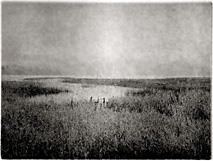At breakfast in the Bonconte Hotel in Urbino, the fellow at the next table saw that I was having trouble making myself understood in Italian. That was hardly surprising, as I don’t speak Italian. What was surprising is that we had met previously at an exhibit opening of mine in Houston, Texas. Neither of us realized it until the next day. My forgetting can be written off to the fact that Houston and Urbino are not exactly sister cities. But in the hierarchy of his memory, my existence made less of an impression than the works, the photogravure etchings. Those he remembered, my self was peripheral. And that is exactly the way I wish to be remembered — to be eclipsed by my images.
Cities, like sculptures and people, look better from some directions than others. With cities, this favored viewpoint, where its composition falls into place as a coherent picture, is not always easy to find.
‘It could be argued’ said Kenneth Clark in the 1970s book and BBC TV series “Civilization” (both still available) ‘that life in Urbino was one of the high water marks of western civilization. (As for the Palace), the arcaded courtyard is calm and timeless — the rooms are so perfectly proportioned that it exhilarates one to walk through them: in fact it’s the only palace in the world that I can go round without feeling oppressed and exhausted’.
A thousand years ago, by contrast, our ancestors lived a life of brutality, ignorance and delusions, one that was – in Thomas Hobbes’ famous phrase – ‘nasty, brutish and short.’
It was an era of treachery, depravity, and barbarism. And if you happened to
have been born into it, there wasn’t a thing you could do about it.
Consider, for example, that during the Middle Ages:
– The vast majority of people were peasants who labored hard for a subsistence living.
– There was no social safety net and hunger was often terrible. During famines, people devoured bark, roots, grass, even clay.
– Political freedoms were nonexistent. Despots, confronted by opposition,
could be counted on to strike back with fury. Enemies of the king were
routinely hanged, drawn and quartered.
– Abduction for ransom was an acceptable means of livelihood for skilled but
landless knights.
– It was an era of shocking everyday violence. Murders were twice as frequent
as death by accident. (And English coroners’ records show that only one of
every hundred murderers was ever brought to justice.)
– Outlaws were seldom pursued. Anyone intrepid enough to travel between
towns alone was on their own. Thieves, kidnappers, and killers simply hid in
the forest and waited. In ‘A World Lit Only By Fire,’ historian William
Manchester writes that, ‘honest travelers carried well-honed daggers,
knowing they might have to kill and hoping they would have the stomach
for it.’
– Villagers were insular, staying close to home and marrying their neighbors.
Local dialects were often incomprehensible to those living only a few miles
away.
– The vast majority of men and women were illiterate and believed in magic,
sorcery and all manner of myths, routinely killing those whose superstitions
were different from and, therefore, an affront to, their own.
– Witch-hunting was a popular sport. When a witch – often someone with a
mental illness – was discovered, he or she was generally put to the stake.
– Sanitation was primitive; plumbing was unknown. Excrement, urine and
offal were simply flung out windows. This created rat and flea infestations.
These, in turn, bred deadly pandemics.
– The Black Death is estimated to have killed up to 60% of Europe’s population in the mid-1300s. At night, carts creaked through town streets, with gravediggers crying out, “Bring Out Your Dead!”
– The Church — often doubling as the government — taxed workers without
their consent, made war on its enemies and offered to erase transgressions
by selling indulgences.
– The threat of capital punishment was often used in religious conversions —
and medieval threats were seldom idle.
– Death was also the prescribed penalty for hundreds of other offenses,
particularly those against property.
– Courts required little evidence and were frequently merciless. A slanderer
might have his tongue ripped out. A thief could have his hand cut off. (And
the medieval age was not a good time to be an adulterer.)
– Females were often married when they reached the age of twelve. Needless
to say, they seldom chose their mates. Parents usually arranged their
children’s marriages by their seventh birthdays.
– The toll at childbirth was appalling. A young girl’s life expectancy was
twenty-four.
– Men rarely reached their late forties. If they did, their hair was as white and their backs as bent as an octogenarian’s today.
– People marked time by the sun, the stars and the changing of the seasons.
There was no such thing as a clock or – apart from the Easter tables at the
local church – anything resembling a calendar.
– To the average person, the earth was flat, the population beset by demons
and the lands beyond the horizon a total mystery.
Today we have a great bias, a widely accepted belief in the steady nature of
human progress. But for most of history there simply was none. There are,
for example, enormous differences between everyday life in 1810 and 2010.
But between 810 and 1010 there were virtually none.


